Low-Loss and Stable Light Transmission in Nano-Core Plus Node-Free Anti-Resonant Hollow-Core Fiber
Abstract
1. Introduction
2. Performance Analysis of NPNANF
2.1. Structure Design of NPNANF
2.2. Working Principle of the NPNANF
2.3. Simulation of Transmission Properties of NPNANF
3. Loss Analysis of NPNANF
3.1. Loss Mechanism
3.2. Optimization of Losses in Hollow-Core and Nano-Core Components
- (1)
- Increasing Air Hole Size: Enlarging the air holes in the hollow-core fiber can help reduce confinement loss by increasing the effective refractive index contrast between the core and cladding, thereby improving the anti-resonance effect;
- (2)
- Improving Material Purity: Reducing impurities in the cladding material helps minimize scattering and absorption losses, contributing to the overall reduction in total transmission loss;
- (3)
- Optimizing Anti-Resonance Structure: Refining the anti-resonant cladding design (e.g., by adjusting the geometry of the air holes) helps minimize scattering loss and improve the confinement of the guided light.
3.3. Loss Calculation and Optimization Results
4. Conclusions
Author Contributions
Funding
Data Availability Statement
Conflicts of Interest
References
- Debord, B.; Amsanpally, A.; Chafer, M.; Baz, A.; Maurel, M.; Blondy, J.-M.; Hugonnot, E.; Scol, F.; Vincetti, L.; Gérôme, F.; et al. Ultralow Transmission Loss in Inhibited-Coupling Guiding Hollow Fibers. Optica 2017, 4, 209–217. [Google Scholar] [CrossRef]
- Nicholson, J.W.; Meng, L.; Fini, J.M.; Windeler, R.S.; DeSantolo, A.; Monberg, E.; DiMarcello, F.; Dulashko, Y.; Hassan, M.; Ortiz, R. Measuring Higher-Order Modes in a Low-Loss, Hollow-Core, Photonic-Bandgap Fiber. Opt. Express 2012, 20, 20494–20505. [Google Scholar] [CrossRef] [PubMed]
- Kolyadin, A.N.; Alagashev, G.K.; Pryamikov, A.D.; Mouradian, L.; Zeytunyan, A.; Toneyan, H.; Kosolapov, A.F.; Bufetov, I.A. Negative Curvature Hollow-Core Fibers: Dispersion Properties and Femtosecond Pulse Delivery. Phys. Procedia 2015, 73, 59–66. [Google Scholar] [CrossRef]
- Feng, Z.; Sakr, H.; Hayes, J.R.; Fokoua, E.N.; Ding, M.; Poletti, F.; Richardson, D.J.; Slavík, R. Hollow-Core Fiber with Stable Propagation Delay between −150 °C and +60 °C. Opt. Lett. 2023, 48, 763–766. [Google Scholar] [CrossRef] [PubMed]
- Chaudhary, V.S.; Kumar, D.; Pandey, B.P.; Kumar, S. Advances in Photonic Crystal Fiber-Based Sensor for Detection of Physical and Biochemical Parameters—A Review. IEEE Sens. J. 2022, 23, 1012–1023. [Google Scholar] [CrossRef]
- Zhu, X.; Wu, D.; Wang, Y.; Yu, F.; Li, Q.; Qi, Y.; Knight, J.; Chen, S.; Hu, L. Delivery of CW Laser Power up to 300 Watts at 1080 Nm by an Uncooled Low-Loss Anti-Resonant Hollow-Core Fiber. Opt. Express 2021, 29, 1492–1501. [Google Scholar] [CrossRef] [PubMed]
- Mangan, B.J.; Farr, L.; Langford, A.; Roberts, P.J.; Williams, D.P.; Couny, F.; Lawman, M.; Mason, M.; Coupland, S.; Flea, R.; et al. Low Loss (1.7 DB/Km) Hollow Core Photonic Bandgap Fiber. In Proceedings of the Optical Fiber Communication Conference, Los Angeles, CA, USA, 23–27 February 2004; p. PD24. [Google Scholar]
- Magbool, A.; Kumar, V.; Bazzi, A.; Flanagan, M.F.; Chafii, M. Multi-Functional RIS for a Multi-Functional System: Integrating Sensing, Communication, and Wireless Power Transfer. IEEE Netw. 2024, 39, 71–79. [Google Scholar] [CrossRef]
- Wheeler, N.V.; Bradley, T.D.; Hayes, J.R.; Gouveia, M.A.; Liang, S.; Chen, Y.; Sandoghchi, S.R.; Abokhamis Mousavi, S.M.; Poletti, F.; Petrovich, M.N.; et al. Low-Loss Kagome Hollow-Core Fibers Operating from the near-to the Mid-IR. Opt. Lett. 2017, 42, 2571–2574. [Google Scholar] [CrossRef] [PubMed]
- Ferreira, M.F.S.; Rodrigues, S.M.G.; Facão, M.M. V Light Propagation in Gas-Filled Kagome Hollow-Core Fibers. In Specialty Optical Fibers; Elsevier: Amsterdam, The Netherlands, 2024; pp. 61–79. [Google Scholar]
- Gao, S.; Wang, Y.; Ding, W.; Jiang, D.; Gu, S.; Zhang, X.; Wang, P. Hollow-Core Conjoined-Tube Negative-Curvature Fibre with Ultralow Loss. Nat. Commun. 2018, 9, 2828. [Google Scholar] [CrossRef]
- Kolyadin, A.N.; Kosolapov, A.F.; Pryamikov, A.D.; Biriukov, A.S.; Plotnichenko, V.G.; Dianov, E.M. Light Transmission in Negative Curvature Hollow Core Fiber in Extremely High Material Loss Region. Opt. Express 2013, 21, 9514–9519. [Google Scholar] [CrossRef]
- Jasion, G.T.; Bradley, T.D.; Harrington, K.; Sakr, H.; Chen, Y.; Fokoua, E.N.; Davidson, I.A.; Taranta, A.; Hayes, J.R.; Richardson, D.J.; et al. Hollow Core NANF with 0.28 DB/Km Attenuation in the C and L Bands. In Proceedings of the Optical Fiber Communication Conference, San Diego, CA, USA, 8–12 March 2020; p. Th4B-4. [Google Scholar]
- Nawazuddin, M.B.S.; Wheeler, N.V.; Hayes, J.R.; Sandoghchi, S.R.; Bradley, T.D.; Jasion, G.T.; Slavik, R.; Richardson, D.J.; Poletti, F. Lotus-Shaped Negative Curvature Hollow Core Fiber with 10.5 DB/Km at 1550 Nm Wavelength. J. Light. Technol. 2017, 36, 1213–1219. [Google Scholar] [CrossRef]
- Sakr, H.; Bradley, T.D.; Jasion, G.T.; Fokoua, E.N.; Sandoghchi, S.R.; Davidson, I.A.; Taranta, A.; Guerra, G.; Shere, W.; Chen, Y.; et al. Hollow Core NANFs with Five Nested Tubes and Record Low Loss at 850, 1060, 1300 and 1625 nm. In Proceedings of the Optical Fiber Communication Conference, Washington, DC, USA, 6–11 June 2021; p. F3A-4. [Google Scholar]
- Jasion, G.T.; Sakr, H.; Hayes, J.R.; Sandoghchi, S.R.; Hooper, L.; Fokoua, E.N.; Saljoghei, A.; Mulvad, H.C.; Alonso, M.; Taranta, A.; et al. 0.174 DB/Km Hollow Core Double Nested Antiresonant Nodeless Fiber (DNANF). In Proceedings of the 2022 Optical Fiber Communications Conference and Exhibition (OFC), San Diego, CA, USA, 6–10 March 2022; pp. 1–3. [Google Scholar]
- Bradley, T.D.; Jasion, G.T.; Hayes, J.R.; Chen, Y.; Hooper, L.; Sakr, H.; Alonso, M.; Taranta, A.; Saljoghei, A.; Mulvad, H.C.; et al. Antiresonant Hollow Core Fibre with 0.65 DB/Km Attenuation across the C and L Telecommunication Bands. In Proceedings of the 45th European Conference on Optical Communication (ECOC 2019), Dublin, Ireland, 22–26 September 2019. [Google Scholar]
- Chen, X.; Hu, X.; Yang, L.; Peng, J.; Li, H.; Dai, N.; Li, J. Double Negative Curvature Anti-Resonance Hollow Core Fiber. Opt. Express 2019, 27, 19548–19554. [Google Scholar] [CrossRef] [PubMed]
- Bradley, T.D.; Hayes, J.R.; Chen, Y.; Jasion, G.T.; Sandoghchi, S.R.; Slavík, R.; Fokoua, E.N.; Bawn, S.; Sakr, H.; Davidson, I.A.; et al. Record Low-Loss 1.3 DB/Km Data Transmitting Antiresonant Hollow Core Fibre. In Proceedings of the 2018 European Conference on Optical Communication (ECOC), Rome, Italy, 23–27 September 2018; pp. 1–3. [Google Scholar]
- Habib, M.S.; Antonio-Lopez, J.E.; Markos, C.; Schülzgen, A.; Amezcua-Correa, R. Single-Mode, Low Loss Hollow-Core Anti-Resonant Fiber Designs. Opt. Express 2019, 27, 3824–3836. [Google Scholar] [CrossRef]
- Wang, Y.; Hasan, M.I.; Hassan, M.R.A.; Chang, W. Effect of the Second Ring of Antiresonant Tubes in Negative-Curvature Fibers. Opt. Express 2020, 28, 1168–1176. [Google Scholar] [CrossRef] [PubMed]
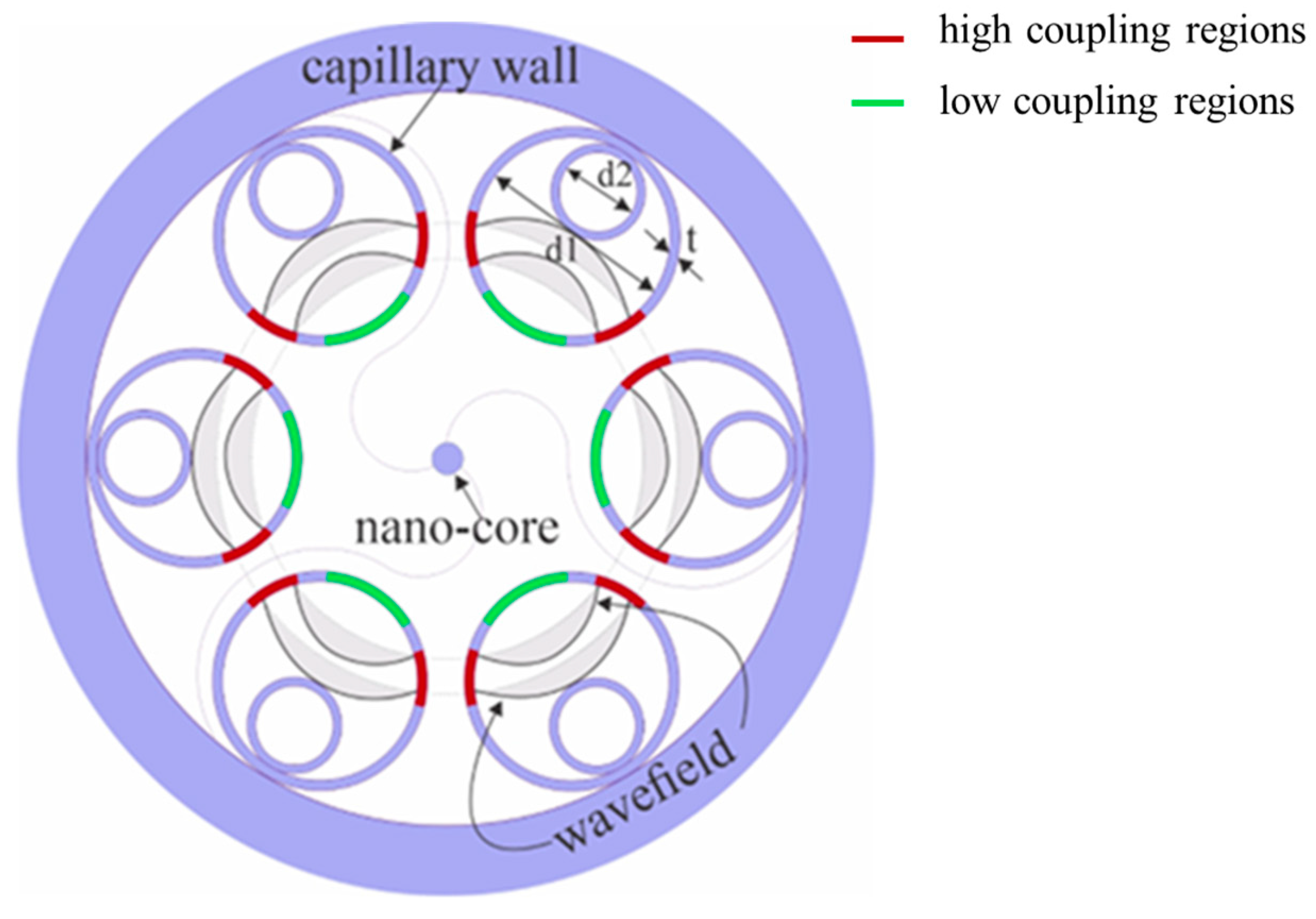
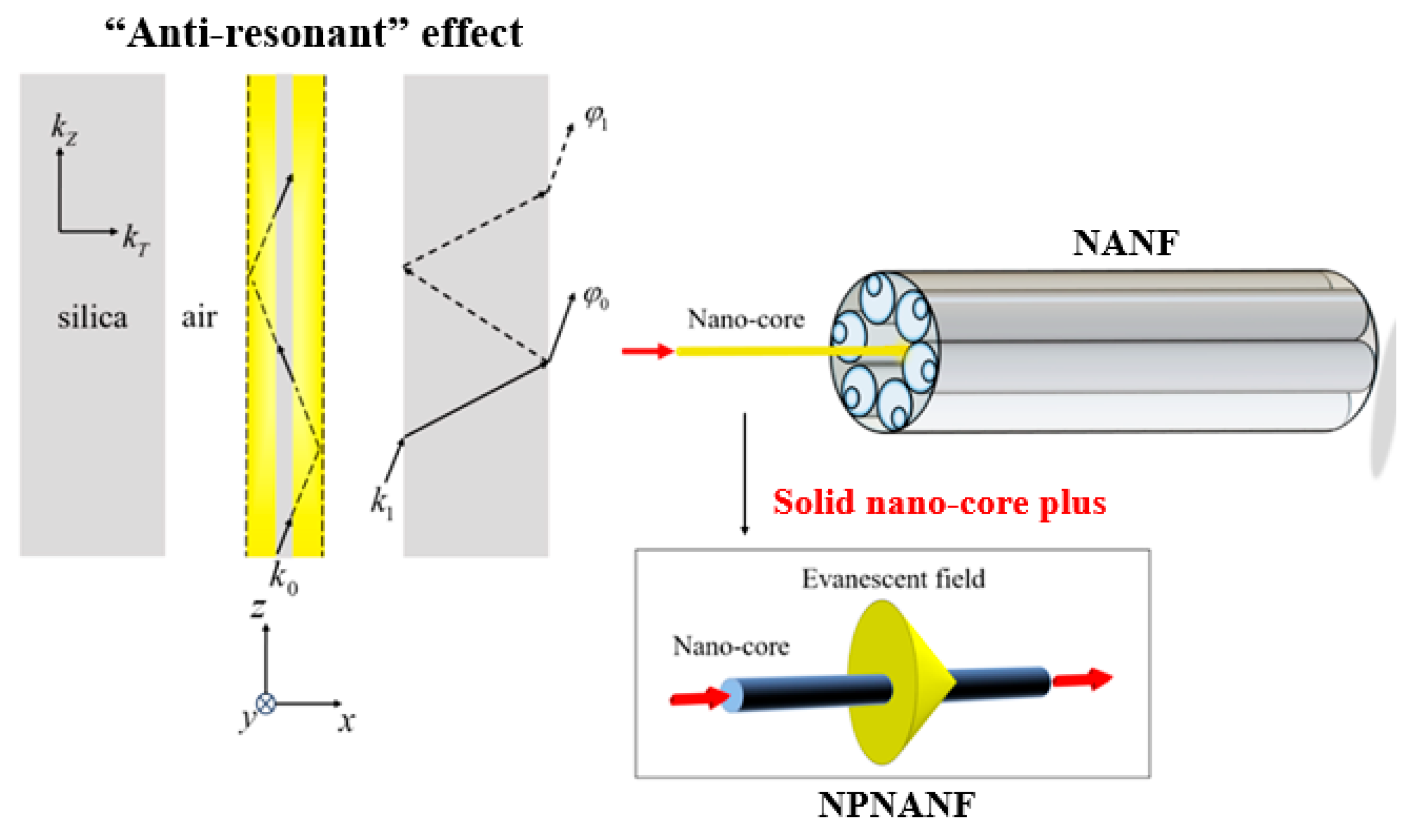
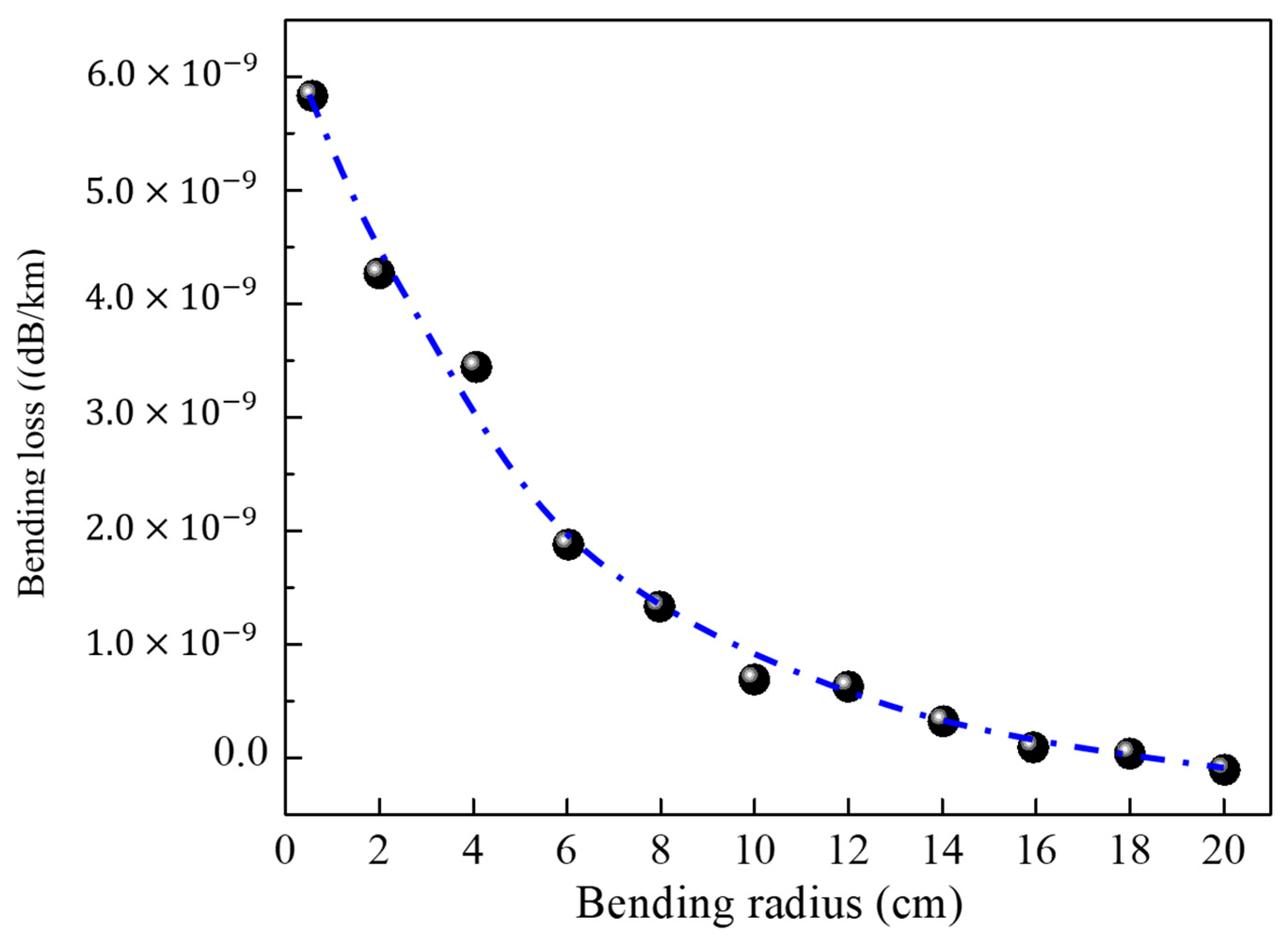
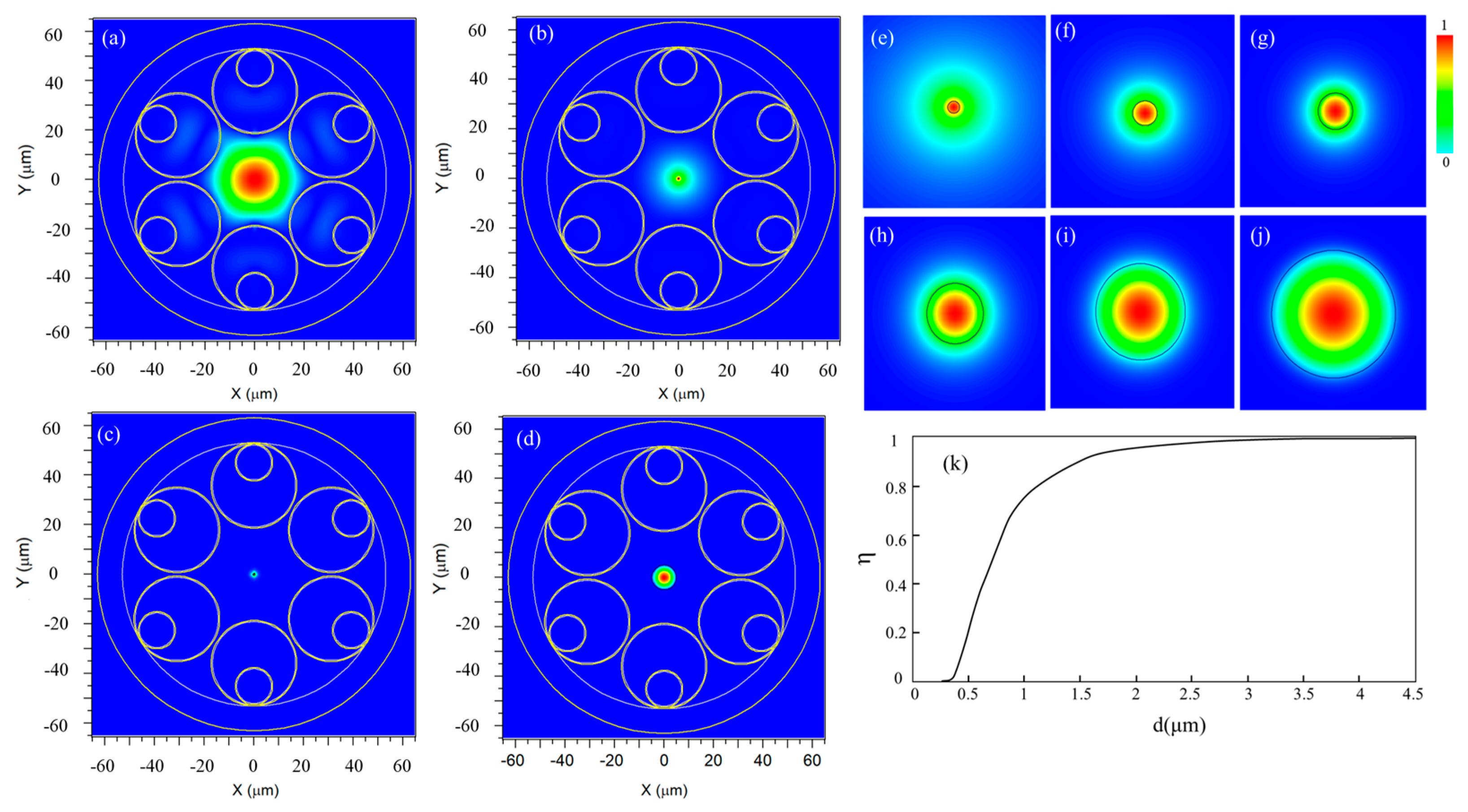
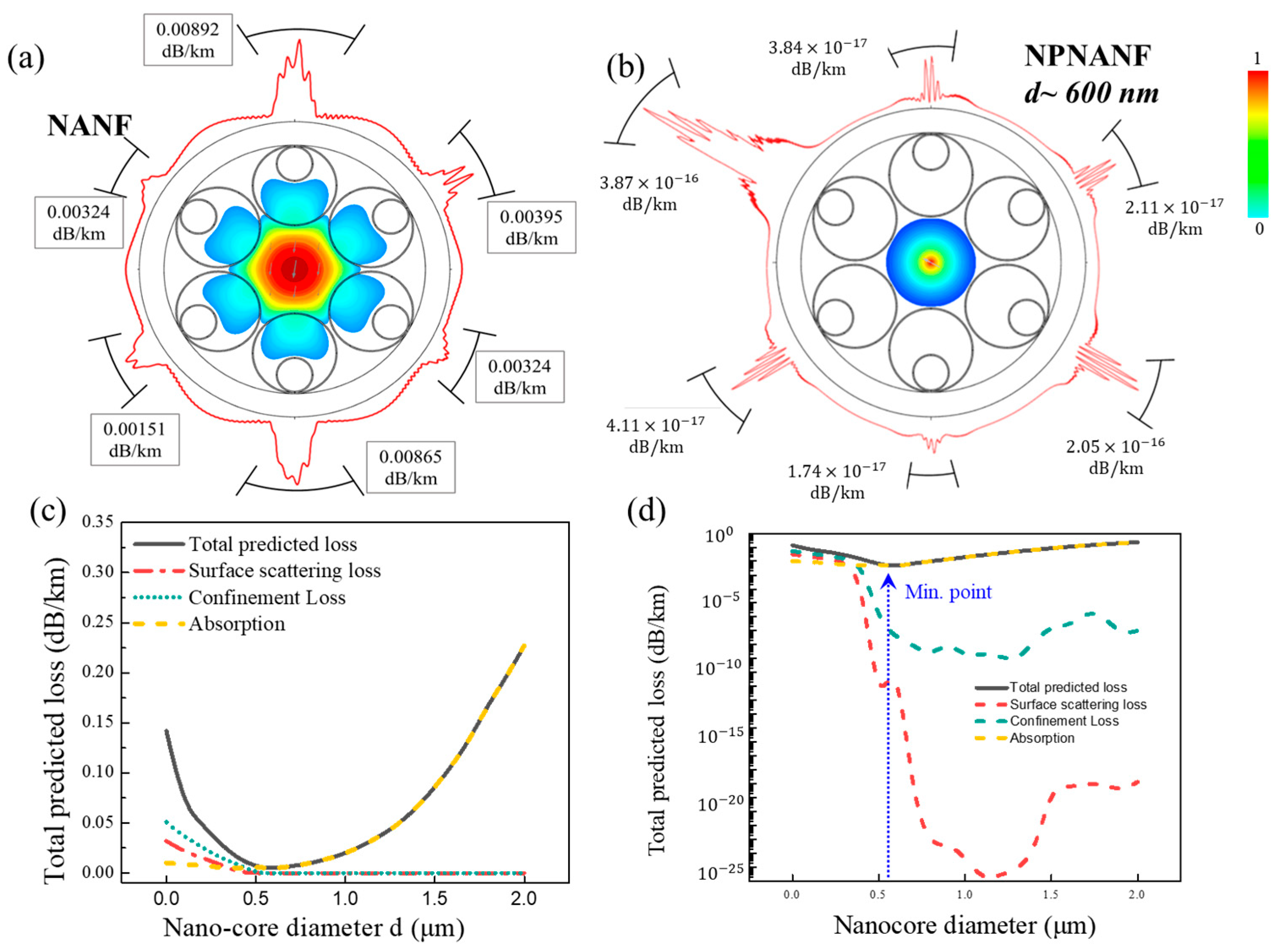

| Fiber Type | Diameter of the Nano-Core d (nm) | d1/d | d2/d | D/d |
|---|---|---|---|---|
| NPNANF | 600 | 16.3 | 3 | 73.3 |
| Year | Bend Loss | Reference |
|---|---|---|
| 2018 | 1 dB/km for R = 10 cm@1512 nm | [11] |
| 2019 | 15 dB/km for R = 1 cm@1550 nm | [20] |
| 2020 | 3 dB/km for R = 7 cm@1550 nm | [21] |
| 2022 | 0.05 dB/km for R = 20 cm@1550 nm | [19] |
| Fiber Type | Diameter of the Nano-Core d (nm) | Loss (dB/km) | Effective Refractive Index |
|---|---|---|---|
| NPNANF | 600 | 0.025 | 1.003 |
| NANF | N/A | 12.98 | 0.99821 |
| Core Diameter (nm) | Loss (dB/km) | Effective Index | Mode Area (μm2) | Core Power Ratio (%) | |
|---|---|---|---|---|---|
| NPNANF | 200 | 1.88 | 1.0018 | 72.1 | 51.2 |
| NPNANF | 400 | 0.24 | 1.0026 | 37.5 | 76.9 |
| NPNANF | 600 | 0.025 | 1.003 | 22.3 | 92.4 |
| NPNANF | 1000 | 0.15 | 1.0042 | 11.9 | 98.1 |
| NANF | — | 12.98 | 0.99821 | >100 | <5.0 |
| Fiber Type | Wavelength (nm) | Loss (dB/km) | Effective Mode Area (µm2) |
|---|---|---|---|
| HC-PBGF | 1550 | ~1.2 | >80 |
| Kagome HCF | 1550 | ≥50 | ~60 |
| NANF | 1550 | 0.22–1.3 | 50–100 |
| DNANF | 1550 | 0.174 | ~30 |
| NPNANF (this work) | 1550 | 0.025 | 22.3 |
Disclaimer/Publisher’s Note: The statements, opinions and data contained in all publications are solely those of the individual author(s) and contributor(s) and not of MDPI and/or the editor(s). MDPI and/or the editor(s) disclaim responsibility for any injury to people or property resulting from any ideas, methods, instructions or products referred to in the content. |
© 2025 by the authors. Licensee MDPI, Basel, Switzerland. This article is an open access article distributed under the terms and conditions of the Creative Commons Attribution (CC BY) license (https://creativecommons.org/licenses/by/4.0/).
Share and Cite
Yin, Y.; Ge, T.; Zhang, T.; Wang, Z. Low-Loss and Stable Light Transmission in Nano-Core Plus Node-Free Anti-Resonant Hollow-Core Fiber. Nanomaterials 2025, 15, 1458. https://doi.org/10.3390/nano15181458
Yin Y, Ge T, Zhang T, Wang Z. Low-Loss and Stable Light Transmission in Nano-Core Plus Node-Free Anti-Resonant Hollow-Core Fiber. Nanomaterials. 2025; 15(18):1458. https://doi.org/10.3390/nano15181458
Chicago/Turabian StyleYin, Yuyi, Tingwu Ge, Tong Zhang, and Zhiyong Wang. 2025. "Low-Loss and Stable Light Transmission in Nano-Core Plus Node-Free Anti-Resonant Hollow-Core Fiber" Nanomaterials 15, no. 18: 1458. https://doi.org/10.3390/nano15181458
APA StyleYin, Y., Ge, T., Zhang, T., & Wang, Z. (2025). Low-Loss and Stable Light Transmission in Nano-Core Plus Node-Free Anti-Resonant Hollow-Core Fiber. Nanomaterials, 15(18), 1458. https://doi.org/10.3390/nano15181458







